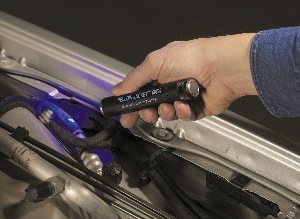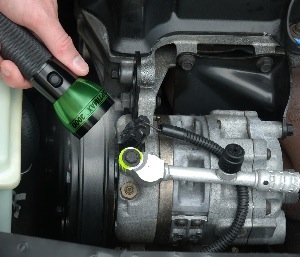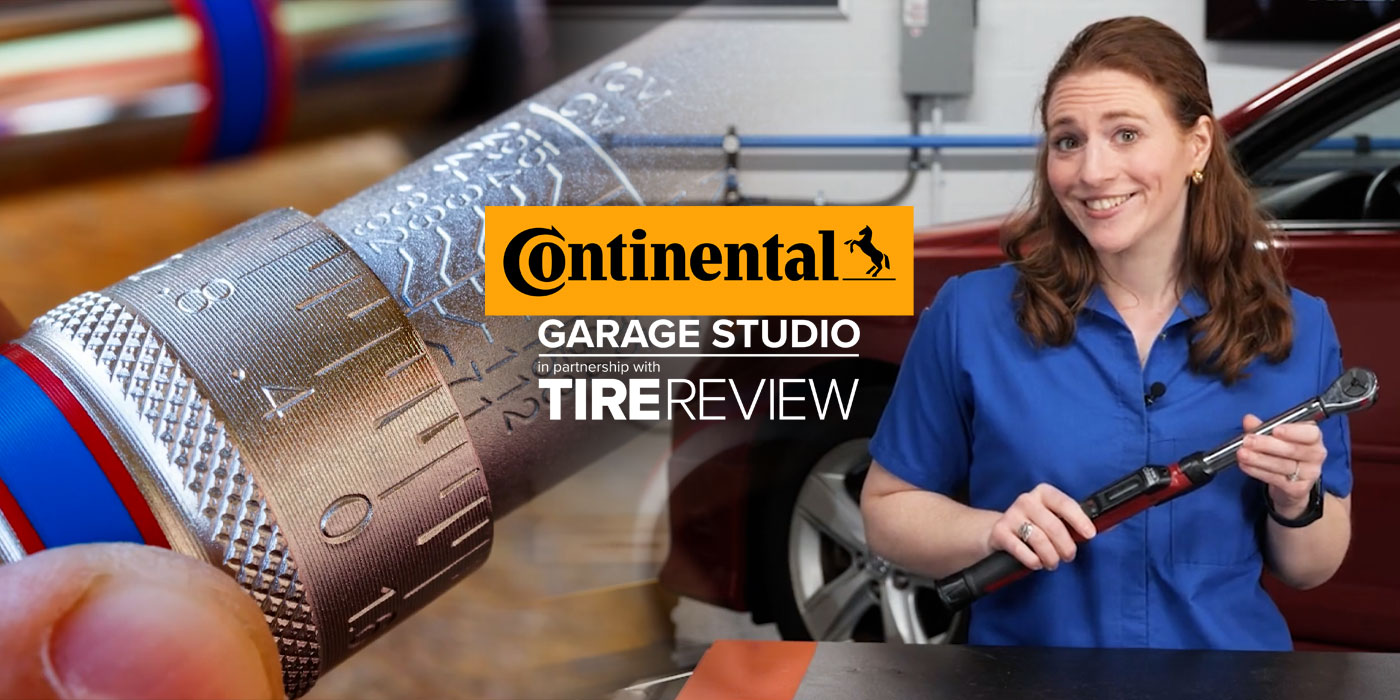Leaks of one kind or another can always be a challenge to find if the leak isn’t obvious. Having the right tools to help you find leaks can save time, effort and reduce the risk of comebacks. Here are some common types of leaks and what kind of equipment you can use to find them.
Refrigerant Leaks
The two most common methods for finding A/C refrigerant leaks are fluorescent dye and electronic leak detection. With dye, a small quantity (about 1/2 ounce) of dye is added to the A/C system with an injector tool. The A/C system is run for a period of time to circulate the dye. An ultraviolet lamp is then used to look for any telltale stains left by the fluorescent dye as it leaks out of the A/C system.
The main advantage of using dye is that it is relatively inexpensive and does not require a big investment in test equipment. A number of vehicle manufacturers add leak detection dye to the refrigerant when they charge the A/C system at the factory, so on these applications you don’t even need to add dye to the system. The only thing you have to be careful about when using dye is not adding too much to the A/C system. Overdosing it with dye increases the risk of gumming up the compressor or orifice tube.
One of the limitations of dye is that it only works if you can see it. An evaporator leak can be hard to detect with this method because the evaporator is sealed up inside the HVAC case under the instrument panel. The dye may eventually show up in water that condenses on the evaporator and drips down the drain tube, but that can take time.
An electronic leak detector is the other means of finding refrigerant leaks. It’s fast, does not require adding anything to the A/C system, and can find “hidden” leaks like those in an evaporator. Most electronic refrigerant leak detectors will detect R-12, R-134a, blends and any refrigerant gas that contains chlorine, fluorine or bromine gas. Many use a heated diode sensor, while others use a corona discharge sensor, cold cathode diode or ion-pump sensor.
Today’s electronic leak detectors are quite sensitive and can sniff out leaks as small as a few fractions of an ounce per year. Costs typically range from $150 to $400 or more. Most are self-calibrating, but do not require any maintenance other than replacing the sensor element when it reaches the end of its useful service life.
Engine Vacuum Leaks
Techs can use propane vapor or throttle spray to search for vacuum leaks, but both techniques can be hazardous. Propane vapor and aerosol solvents are flammable, and there may be some risk of damaging a plastic intake manifold with a chemical cleaner.
The smart way to find vacuum leaks is with a general-purpose smoke machine. These machines sell for a few hundred dollars to more than $1,000, and come with various fittings for injecting smoke into the intake manifold, vacuum hoses and other parts.
A general-purpose smoke machine typically operates at very low pressure, only about 1 to 1.5 psi, though there are models available that operate at higher pressures (up to 15 psi). The machine heats mineral oil to create a nontoxic, vapor-like mist similar to that produced by a fog machine. A small pump then blows this “smoke” through a hose, which can be connected to the PCV hose, brake booster hose or any hose or vacuum fitting to check for leaks. If you are checking for a vacuum leak, after a minute or two there is usually enough smoke inside the intake manifold to start seeping out if there are any leaks. The smoke is white and can be easily seen with a shop light.
You can also use UV dye additive with the smoke to make really small leaks easier to find. The dye will leave a telltale stain that will glow when it’s illuminated by a UV light.
Caution: Check with the vehicle manufacturer before introducing dye. Some manufacturers prohibit the use of dyes in their vehicles, and the effect of the dye on vehicle sensors is not fully understood.
A general-purpose smoke machine can also be used to find a variety of leaks including exhaust leaks (blow smoke up the tailpipe), compression leaks (blow smoke into the combustion chamber through the spark plug hole), oil leaks (blow smoke into the crankcase through the PCV valve opening or dipstick tube), and even coolant leaks (blow smoke into the radiator after draining the system). Almost any part that normally holds pressure or vacuum can usually be tested for leaks with a smoke machine, including turbocharger intercoolers, brake vacuum boosters, vacuum plumbing and motors in HVAC systems, air inlet ducts between the throttle and air filter – and even tires.
EVAP Leaks
Another use for a smoke machine is to find fuel vapor leaks in the evaporative emission control (EVAP) system. But a general-purpose smoke machine should NOT be used for this kind of leak detection. EVAP leak detection requires a special type of smoke machine, one that has been designed for EVAP leak detection.
An EVAP smoke machine is designed to operate at a very low pressure (only about 0.5 psi) so there is no risk of over-pressurizing the system. Forcing too much pressure into the EVAP system might blow off a hose or create a leak that wasn’t there in the first place. There is also a timer that shuts off the machine after a predetermined period of time so an unattended machine won’t pump out too much gas and smoke.
Another really useful feature on an EVAP-approved machine is a flow meter or gauge. This allows you to “see” whether or not the EVAP system is leaking without having to look for the smoke. If the flow meter continues to show flow into a pressurized system, then there is a leak and the flow meter reading will give an approximation of the size of the leak. The minimum size leak that will display on the flow meter of today’s diagnostic smoke machines is about 0.015 inch.
Some smoke machines also provide an output pressure gauge. If the machine is equipped with appropriate valves, the pressure gauge will allow the operator to perform a pressure decay (leak down) test. This provides for the diagnosis of very small leaks and the quick confirmation that a repair is complete.
Diagnostic smoke machines are essential tools for today’s automotive technician. The EPA has reported statistics indicating that the majority of problems setting a check engine light are related to a leak somewhere. The fast, safe and reliable diagnosis and location of the leak are keys to the success of a profitable repair and a satisfied customer.
Coolant Leaks
Any one of several methods can be used to find coolant leaks. If coolant is dripping from under a vehicle but it isn’t obvious where the leak is coming from, adding UV dye to the cooling system, running the engine, then using a UV light to look for leaks may help pinpoint the source. This can be helpful for finding leaky freeze plugs, pinhole leaks in radiators or very small leaks that may be hard to detect.
If an engine is using coolant and/or overheating, but no coolant leak can be seen, the engine probably has an internal leak (bad head gasket or a cracked head or block). One vital piece of equipment that can help find this kind of leak is a cooling system pressure tester. The tester hooks up to the radiator cap or coolant reservoir, and uses a hand pump or shop air to pressurize the system to its normal operating pressure. If the cooling system cannot hold pressure for 10 minutes or so, it indicates an internal leak.
An infrared exhaust analyzer can also be used to sniff out internal coolant leaks by sampling the vapors at the coolant reservoir or radiator cap opening when the engine is running. If the analyzer picks up any HC or CO readings within the cooling system, it signals the leakage of combustion gases into the cooling system past a bad head gasket or cracks in the head.
Oil Leaks
As mentioned earlier, a general-purpose smoke machine can help you find leaky seals or gaskets by pressurizing the crankcase and filling it with smoke. Oil leaks can also be pinpointed by adding UV dye to the oil, running the engine and then searching for leaks with a UV light.
Water Leaks & Wind Noise
Water leaks into a vehicle’s interior that can cause musty odors and rust can be hard to pinpoint because water can travel some distance from an entry point. Wind that whistles past leaky door or window seals can also be hard to isolate since sound can reflect off other surfaces, masking the original source.
Once again, a general-purpose smoke machine can help. In this type of application, a smoke diffuser is used with the machine. The interior of the car is not pressurized with smoke, so the A/C or heater fan is turned on high to pull in outside air and pressurize the vehicle’s interior. The smoke is then directed from outside the car along suspected leak points (door seals, the base of the windshield, etc.). If the smoke blows away from the vehicle, it indicates air leaking out of the vehicle.













